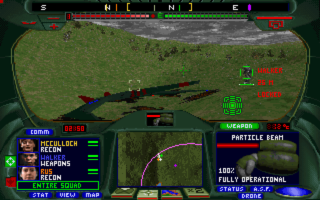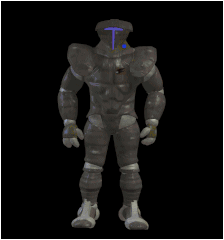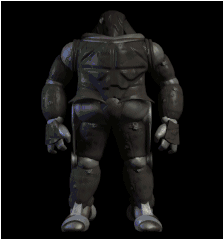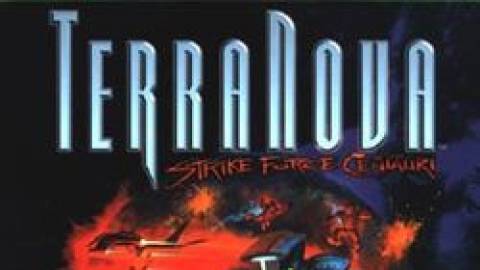Overview
Released in 1996 by publisher Looking Glass Studios, who also developed it, Terra Nova: Strike Force Centauri is a PC first-person action game with an emphasis on squad-level tactics. It takes place within a dystopian future setting in which Earth's star system is controlled by an authoritarian government known as the Hegemony, leading a small group of rebellious dissidents to colonize the Alpha Centauri system. From this original group of settlers, twelve individual clans sprung up, splintering the population and making it vulnerable to pirate activity. This prompts the creation of the titular Strike Force Centauri (or SFC), a military force which was devised to bring together the best from across the clans to protect the interests of the Centauri system as a whole. As the squad leader of the SFC, the player is responsible for undertaking a variety of missions in defense of Centauri while also being charged with directing up to three additional squad members in battle.
Terra Nova utilizes the same game engine that powered some of Looking Glass Studios' previous games, including Ultima Underworld: The Stygian Abyss and System Shock, though it differentiates itself visually from its predecessors through the rendering of large outdoor environments. Its development cycle was famously protracted in comparison to previous Looking Glass releases, and when it came out in 1996 it was noted by many critics that its graphical presentation did not compare well with other contemporary games. In spite of this, overall critical appraisal of Terra Nova, specifically of its gameplay and overall quality, was positive. The title unfortunately sold only moderate numbers in the face of strong competition within the first-person market, and Terra Nova would go on to be widely viewed as one of Looking Glass Studios' biggest financial failures, as it didn't sell well enough to recover the cost of its lengthy development, which was compounded by the fact that it was self-published.
Development
Development on Terra Nova started in 1992 shortly after shipment of Ultima Underworld, and was in concurrent development with its sequel, Ultima Underworld II: Labyrinth of Worlds. According to Dan Schmidt, the credited project lead for Terra Nova, the title was conceived of by a newly hired programmer at Looking Glass, who envisioned it as a simulation-style game focusing on the actions of a small squad of soldiers in powered battle suits. Early in development, the intention was to make Terra Nova's gameplay extremely realistic, with objects and even AI within its world behaving in believable ways. While Ultima Underworld II would be released in early 1993, and an additional title, System Shock, would be conceived, developed, and released by the company in 1994, Terra Nova remained in continued development, a fact which Schmidt attributed both to a lack of any clear deadline for the project, as well as a general lack of direction that ensued after the programmer who spearheaded the title left the company. Schmidt also asserted that his ascension from AI programmer to lead programmer (he would later become the project lead) was largely a result of there being "a void to fill."
Further delaying the release of Terra Nova was the decision to add FMV cutscenes to the game, which required significant development resources be redirected for their production. Schmidt later stated that the decision was made from "up above" largely out of a perceived necessity for the developers to keep up with the gaming zeitgeist at the time. Games which used large amounts of FMV, like 1994's Wing Commander III: Heart of the Tiger, were being lauded by many as the future of gaming, and some within the company felt the game's cutscenes, which were initially planned to be more simple, had to be expanded in scope. The game was already years in development when the call was made to add FMV, and in retrospect, said Schmidt, creating them was probably a mistake for a number of reasons. Schmidt called them "a giant distraction" for the developers, while the cost of producing them increased the number of units the game had to sell just to break even. Shchmidt stated that they "ended up just costing us more and delaying the game even more" without actually increasing the game's potential sales numbers.
Within the last year of its development, Terra Nova's gameplay underwent a significant overhaul, as six months before its release, Schmidt said, the game simply "wasn't fun at all." The changes largely removed some of the more complex simulation aspects of the game, such as a physics system that Looking Glass "just couldn't get ... to work robustly enough for a shipping game," said Schmidt. In place of these mechanics, Terra Nova was transformed into a game with less of an emphasis on realism, and more of a focus on "arcadey" elements. Such drastic changes were likely made as a result of growing fears about the fate of the project and increased pressure to release the game, as Schmidt felt "at some point Terra Nova had to ship or the company was going to go under or we were going to cancel it." While Schmidt admitted via interview that his sentiments regarding Terra Nova overall are somewhat negative, he remained positive about the last-minute changes, saying that "we actually ended up shipping something that was at least somewhat enjoyable to play."
Story
Set within the Alpha Centauri system during the 24th century, Terra Nova begins by depicting the formation of Strike Force Centauri, a military group designed to unify the Centauri clans against piratacy, and the game officially commences as the player character, Nikola ap Io, assumes the responsibilities of squad leader. Early on, the SFC combats only pirate groups, but before long it becomes clear that the pirates are receiving aid from an unknown ally. As Nikola and his team dig further, it is revealed that the pirates' secret supporter is none other than the Earth Hegemony, the totalitarian regime that forced the current residents of Centauri to flee the Sol System in search of a home free from persecution. Upon discovering Earth's involvement, Creon Pentheus, the system's Hegemony ambassador, formally announces the annexation of the Centauri colonies, which is met quickly by a declaration of war from the Centauri Council.
With the threat of the Hegemony renewed, the SFC refocuses its efforts in order to fight them. Over time, though, a series of uncanny Hegemony ambushes as well as the capture of Nikola lead the SFC to realize that there is a Hegemony mole within their midst who isfeeding information to their enemy. After being rescued, Nikola is successfully able to divine that the mole's identity is Simon Ashford, which he discovers by covertly infiltrating a pirate base and unscrambling the informant's transmissions. This realization is not in time to save the SFC's commanding officer, Arlen MacPherson, who succumbs to poisoning, presumably at Ashford's hands. Upon being outed as a traitor, Ashford shows no remorse for his actions, and chooses to jump to his own death from the doors of an SFC flight bay rather than face trial and imprisonment. No longer worried that the Hegemony will have foreknowledge of their actions, the SFC redoubles its efforts to drive the invaders from their system.
As the war continues, Nikola and his team deal with a number of threats from the Hegemony, such as the revelation that their armies are being bolstered by cybernetically-enhanced clone warriors bred specifically for combat. The SFC is eventually able to destroy the Hegemony's clone production facilities, and also fend off several attempts by Earth government to gain permanent footholds within the system. In the end, the Hegemony is forced to withdraw to Carpaccio Station on the planet Thatcher, and it is there that the SFC forces a final confrontation, destroying the base and all Hegemony forces within it by attaching a powerful explosive device to its fuel source before detonating it from a distance. In the aftermath of the war, Earth government denies any involvement, painting ambassador Pentheus as an outlier who acted without authorization. While the SFC is enraged by this disavowal, they take solace in the knowledge that they are still free men.
Gameplay

Terra Nova's gameplay takes place entirely within the first person, and though there are a few exceptions to the rule, combat is its primary focus. The player is equipped in all missions with powered battle armor, or PBA, which provides advanced movement, targeting, and offensive capabilities, as well as numerous auxiliary functions. As the game progresses, additional suit types become available, as well as more weapon and equipment choices, and it is up to the player to decide on a per-mission basis which PBA to use and how best to outfit it. Gameplay is broken up into a series of short missions, and while the progression from one mission to the next is entirely linear, the player is usually given some leeway in how they can accomplish their objectives. Scenarios oftentimes can have varying levels of success, and the player can furthermore earn commendations in the form of medals for achieving certain feats, such as consistently bringing squad mates back without injury.
In order to display the wealth of information that players must decipher while piloting a PBA, Terra Nova employs a multi-function display, or MFD, interface that is quite similar to the one used in the previously-released Looking Glass title, System Shock. As in System Shock, the MFD is broken up into three distinct panes. The leftmost pane is used to display information pertinent to the player's squad members while also allowing easy access to squad commands. The central pane is devoted entirely to one's mission map, which shows nearby targets of interest and also any nav points the player has set. Lastly, the rightmost pane is dedicated to the management, selection, and activation of various weapons and auxiliary suit functions while also providing overall status readouts. The game is controlled through a combination of mouse and keyboard controls; movement is contolled through the keyboard, with numerous additional hotkeys assigned to common functions, while the mouse is used to taget and attack objects within the environment, and also to interact with the game's heads-up display.

The player is accompanied in almost all missions by up to three of their SFC squad mates. As the ranking officer in the field, the player is able to issue orders to any soldiers in their group, which can take the form of general mandates on what combat tactics should be employed, to more specific directives to attack specified targets, hold a given point, or follow the squad leader. Each squad member falls under one of five specializations: weapon, recon, repair, demolition, or electronics. Depending on what specialization a member possesses, the squad leader may be able to issue additional orders such as demolishing an emplacement or rewiring enemy equipment. The player has some control over what squad mates are taken into battle in a given scenario, though in many cases missions have set requirements for squad makeup. A mission that entails finding and recovering a downed ally in a damaged PBA suit, for instance, will have hard requirements for repair and electronic specialists.
Pre-mission customization also extends beyond simply determining what members of the SFC will partake in the coming mission, as most aspects of the PBAs used in battle can be customized prior to commencement of the mission proper. Both the player's and all squad mate's PBAs can be fully customized, which includes not only determining weapon and ASF loadouts, but also what model of PBA is used by each member. Equipment availability is predetermined to an extent, with more advanced equipment and weapons that replace older technology becoming available only as the game progresses, though there is still space within these confines for the player to significantly impact the outcome of a mission through their choices. A time-sensitive objective, for example, might be easier to accomplish in a speedy recon suit rather than a more cumbersome heavy PBA.
Though a multiplayer component was originally slated to be included in the final product, the long and somewhat troubled development cycle of Terra Nova led Looking Glass to ship the game with only single-player modes, which included a 37-mission campaign (not counting tutorial missions) and a random battle mode which generates custom missions based on player-specified parameters. Looking Glass publicly expressed a desire to patch the game post-release in order to add multiplayer functionality to the game, though this never came to pass.
Personal Battle Armor (PBA)
Nikola ap Io and his squad, as the best the Centauri system has to offer, are privy to the latest in powered armor suit technology. The Centaurians as a people are known for their technical prowess, and because of that it is without surprise that their PBAs outstrip even those of the powerful Hegemony. The PBA suits used by Nikola and his squad, known as XR-5 suits, are advanced even by Centauri standards, and are made available exclusively to the SFC. All PBAs come standard with jump jets, advanced sensor equipment, and rechargeable shielding, not to mention a variety of other advanced electronics. Weapons are arm-mounted, and depending on the model a PBA can hold up to four individual armaments. In spite of the incredible resources available to the Hegemony and the speed at which they can produce their terrible bio-mechanical cloned shock troops, the technological advantage of the Centauri people allows them to remain on even footing even when greatly outnumbered. Over time, additional variants of the main XR-5 suit become available for use.
Weapons
All of Terra Nova's non-ASF weapons are mounted on the arms of the PBA suit. Depending on the suit type, up to four can be carried simultaneously, and the player can cycle between them through either the MFD or the number keys '1' through '4' on their keyboard. Though most armaments only require a single slot, a few of the weightier ones require two open slots to equip, and in extreme cases a heavy weapon might only be viable to equip when piloting the Heavy Suit. In general, weapons can either be categorized as energy-based or projectile-based. The former type uses rechargeable energy stores, and provides essentially unlimited uses, while the latter can be fired a finite number of times, though typically with a greater damage potential per shot. Certain specialty weapons exist as well, such as an EM Emitter that helps locate enemies, and others reward players for using them situationally; heavy explosives, for example, can be far more effective when used on groups.
Energy Weapons
Projectile Weapons
Auxiliary Suit Function (ASF)
Any customized equipment within a PBA that is not classified as a weapon is designated as an ASF, or Auxiliary Suit Function. Regardless of type, each suit can be fitted with exactly one ASF, with their main purpose being to provide additional tactical options while engaged in a mission. An ASF can be activated through the MFD or by pressing the '5' key, and most can be used a finite number of times. Squad mates who possess their own ASFs, such as Demolition or PBA Repair Packs, can usually be ordered to use them through the 'F5' menu after first selecting them. While players can assign ASFs themselves for the most part, certain mission objectives may dictate that at least one member of the squad carry a specified ASF. In addition to regular ASF's, the squad leader is also equipped with Drones, which are yet another auxiliary function that only the player can use. Drones act as aerial scouting tools that can provide advanced reconnaissance and target spotting, and the squad leader carries a limited supply of them at all times.

 PC
PC



























